1996 CHEVROLET CAVALIER wheel torque
[x] Cancel search: wheel torquePage 233 of 372
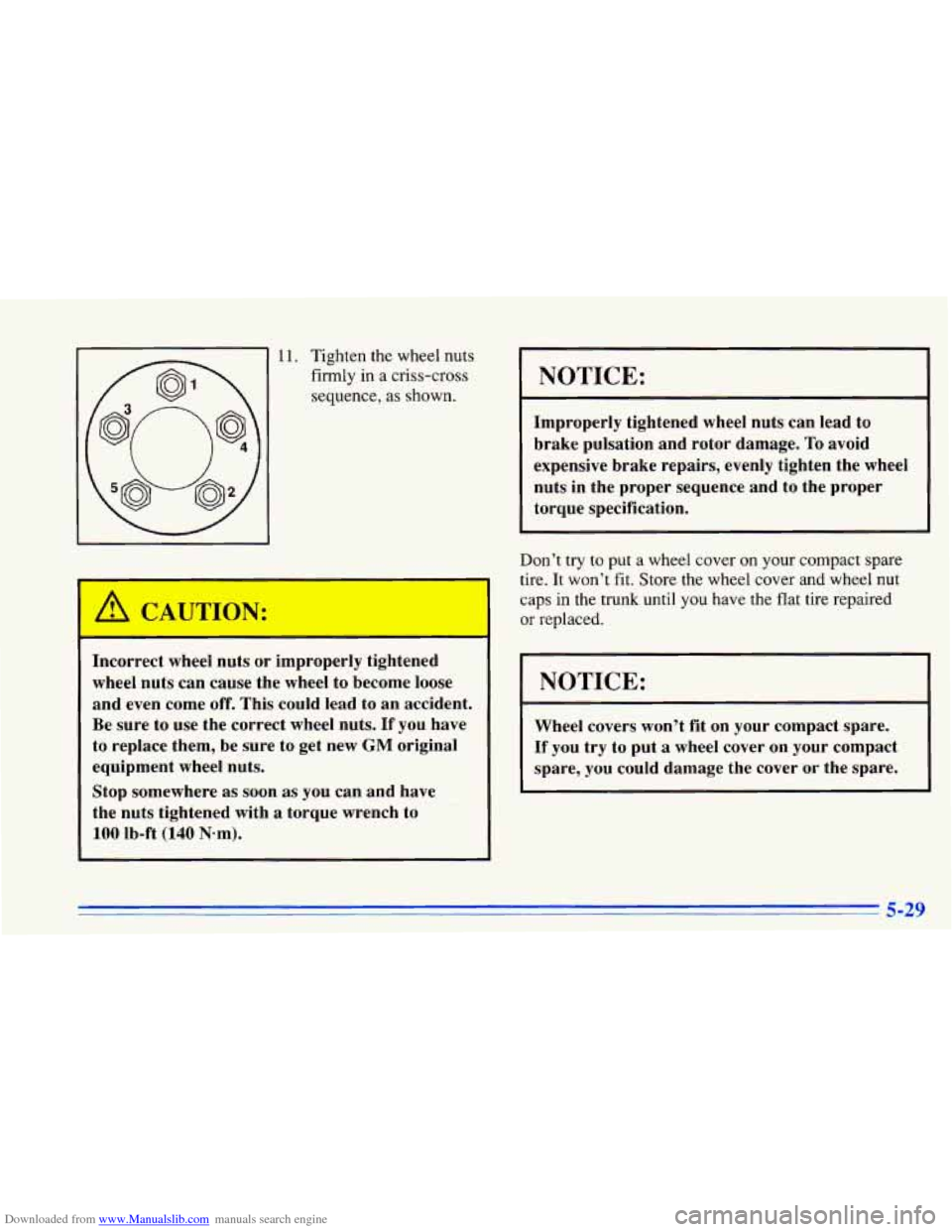
Downloaded from www.Manualslib.com manuals search engine A CAU [ON:
11. Tighten the wheel nuts firmly in a criss-cross
sequence,
as shown.
Incorrect wheel nuts or improperly tightened
wheel nuts can cause the wheel to become loose
and even come off. This could lead to an accident.
Be sure to use the correct wheel nuts. If you have
to replace them, be sure to get new
GM original
equipment wheel nuts.
Stop somewhere as soon
as you can and have
the nuts tightened with
a torque wrench to
100 Ib-ft (140 N-m).
NOTICE:
Improperly tightened wheel nuts can lead to
brake pulsation and rotor damage.
To avoid
expensive brake repairs, evenly tighten the wheel
nuts in the proper sequence and to the proper
torque specification.
Don’t try to put a wheel cover on your compact spare
tire. It won’t fit. Store the wheel cover and wheel
nut
caps in the trunk until you have the flat tire repaired
or replaced.
NOTICE:
Wheel covers won’t fit on your compact spare.
If you try to put a wheel cover on your compact
spare,
you could damage the cover or the spare.
5-29
Page 268 of 372
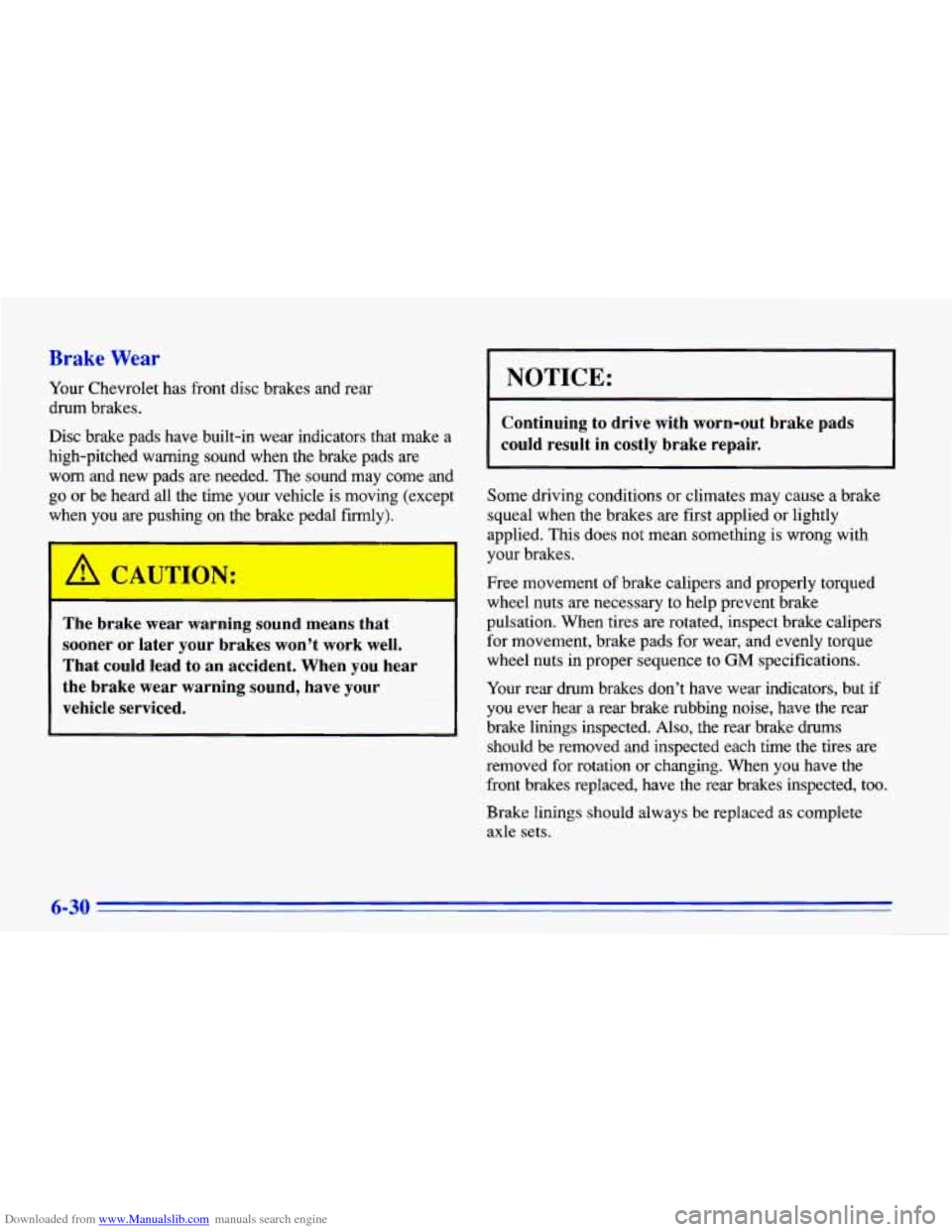
Downloaded from www.Manualslib.com manuals search engine Brake Wear
Your Chevrolet has front disc brakes and rear
drum brakes.
Disc brake pads have built-in wear indicators that make a
high-pitched warning sound when the brake pads are
worn and new pads
are needed. The sound may come and
go or be heard all the time your vehicle is moving (except
when you
are pushing on the brake pedal fiily).
L
The brake wear warning sound means that
sooner or later your brakes won’t work well.
That could lead to an accident. When you hear
the brake wear warning sound, have your
vehicle serviced.
NOTICE:
Continuing to drive with worn-out brake pads
could result in costly brake repair.
Some driving conditions or climates may cause a brake
squeal when the brakes are first applied or lightly
applied. This does not mean something is wrong with
your brakes.
Free movement of brake calipers and properly torqued
wheel nuts are necessary to help prevent brake
pulsation.
When tires are rotated, inspect brake calipers
for movement, brake pads for wear, and evenly torque
wheel nuts in proper sequence to
GM specifications.
Your rear drum brakes don’t have wear indicators, but if
you ever hear a rear brake rubbing noise, have the rear
brake linings inspected. Also, the rear brake drums
should be removed and inspected each time the tires are
removed for rotation
or changing. When you have the
front brakes replaced, have the rear brakes inspected, too.
Brake linings should always be replaced
as complete
axle sets.
6-30
Page 276 of 372
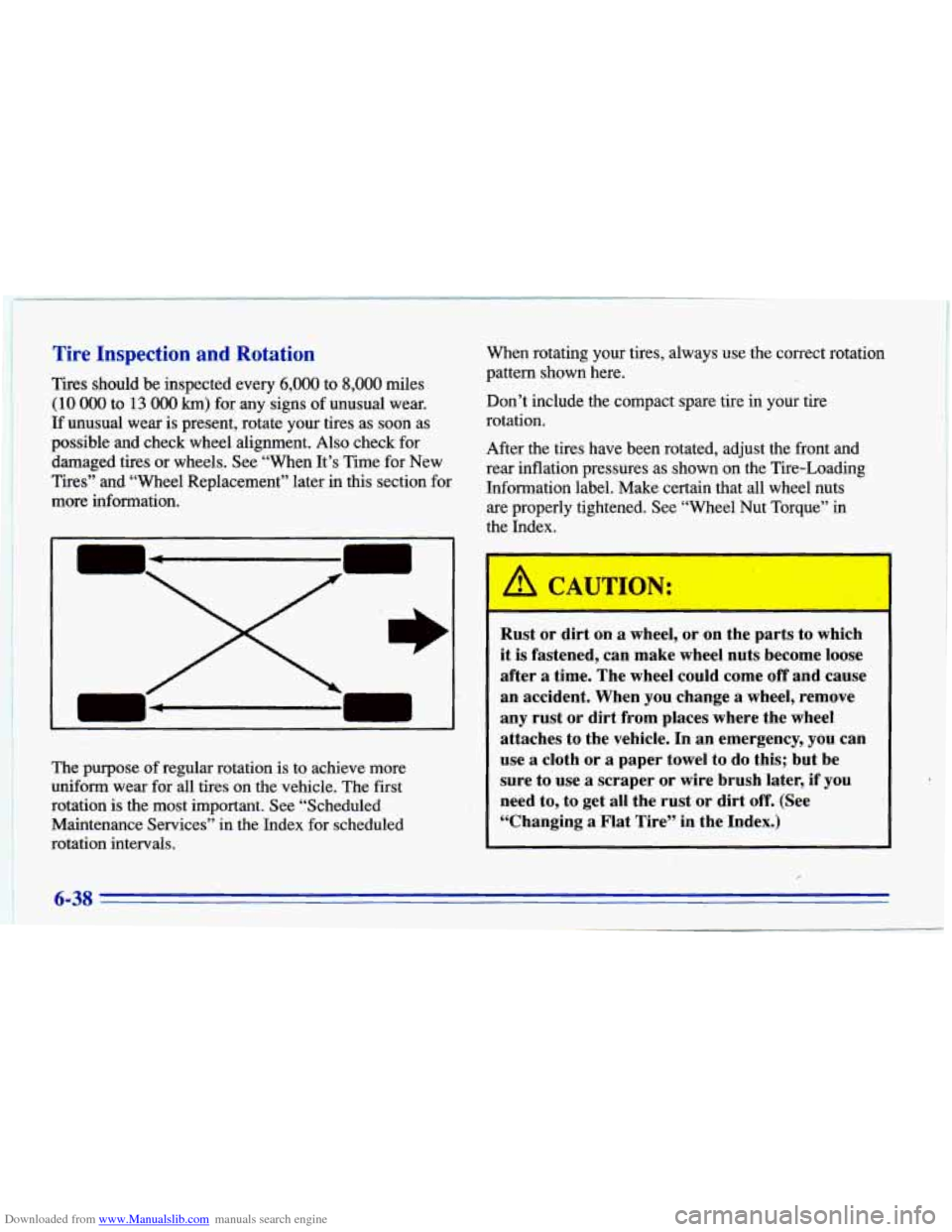
Downloaded from www.Manualslib.com manuals search engine Tire Inspection and Rotation
1 Tires should be inspected every 6,000 to 8,000 miles
(10 000 to 13 000 km) for any signs of unusual wear.
If unusual wear is present, rotate your tires as soon as
possible and check wheel alignment. Also check for
damaged tires or wheels. See “When It’s Time for New
Tires” and “Wheel Replacement” later in this section for
more information.
The purpose of regular rotation is to achieve more
uniform wear for all tires on the vehicle. The first
rotation is the most important. See “Scheduled
Maintenance Services” in the Index for scheduled
rotation intervals. When rotating your tires, always use the Correct rotation
pattern shown here.
Don’t include the compact spare tire
in your tire
rotation.
After the tires have been rotated, adjust the front and
rear inflation pressures as shown on the Tire-Loading
Information label. Make certain that all wheel nuts are properly tightened. See “Wheel Nut Torque” in
the Index.
A CAUTION:
Rust or dirt on a wheel, or on the parts to which
it is fastened, can make wheel nuts become loose
after
a time. The wheel could come off and cause
an accident. When you change
a wheel, remove
any rust or dirt from places where the wheel
attaches to the vehicle. In an emergency, you can
use a cloth or a paper towel to do this; but be
sure to use
a scraper or wire brush later, if you
need to, to get all the rust or dirt
off. (See
“Changing
a Flat Tire” in the Index.)
,
6-38
Page 296 of 372
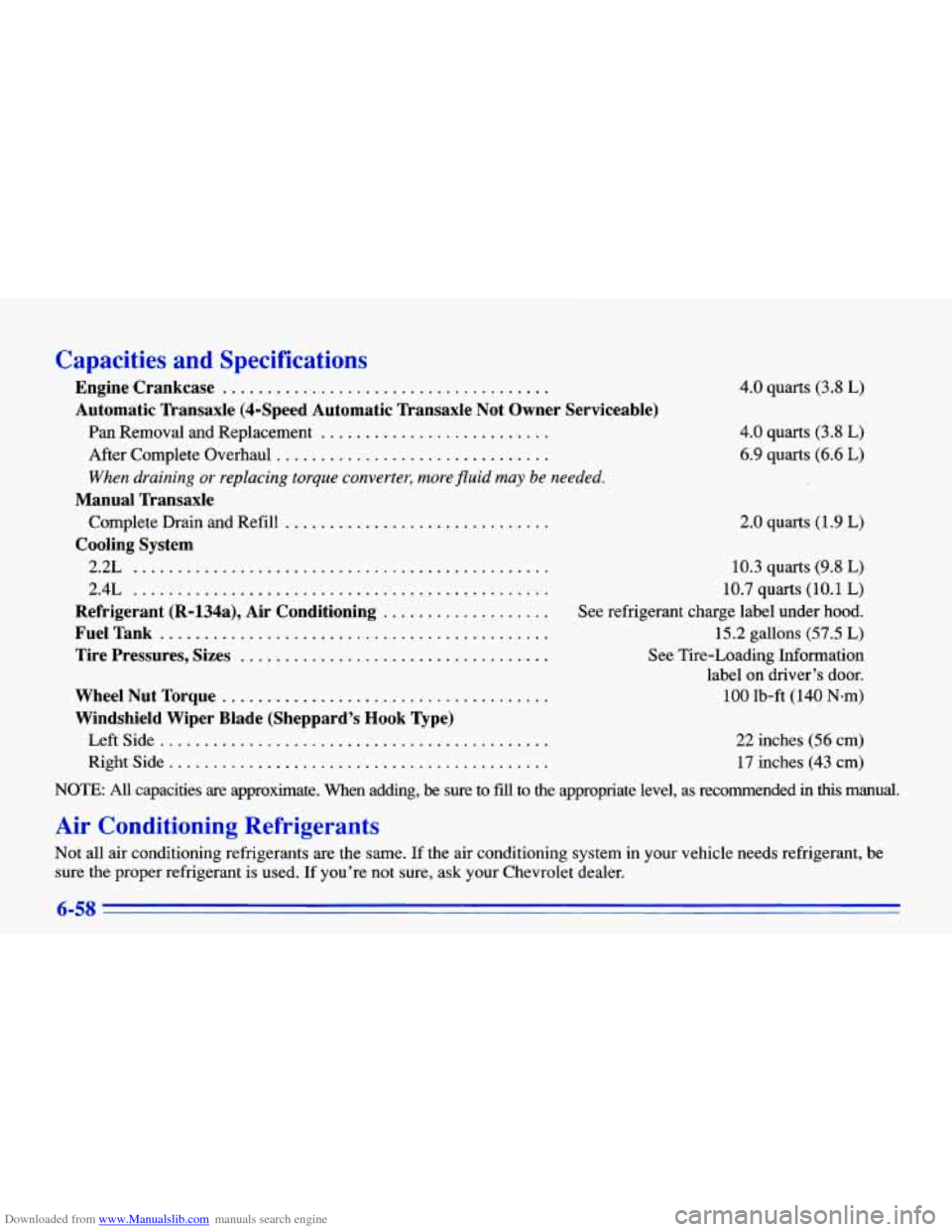
Downloaded from www.Manualslib.com manuals search engine Capacities and Specifications
Engine Crankcase .....................................
Automatic Transaxle (4-Speed Automatic Transaxle Not Owner Serviceable)
Pan Removal and Replacement ..........................
After Complete Overhaul ...............................
When draining or replacing torque converter, more fluid may be needed.
Complete Drain and Refill ..............................
2.2L ...............................................
Manual Transaxle
Cooling System
2.4L ...............................................
Refrigerant (R-l34a), Air Conditioning ...................
FuelTank ............................................
Tire Pressures, Sizes ...................................
WheelNutTorque .....................................
Windshield Wiper Blade (Sheppard’s Hook Type)
LeftSide ............................................
Rightside ...........................................
4.0 quarts (3.8 L)
4.0 quarts (3.8 L)
6.9 quarts (6.6 L)
2.0 quarts (1.9 L)
10.3 quarts (9.8 L)
10.7 quarts (10.1 L)
See refrigerant charge label under hood.
15.2 gallons (57.5 L)
See Tire-Loading Information
label on driver’s door.
100 lb-ft
(140 N-m)
22 inches (56 cm)
17 inches (43 cm)
NOTE: AU capacities are approximate. When adding, be sure to fiil to the appropriate level, as recommended in this manual.
Air Conditioning Refrigerants
Not all air conditioning refrigerants are the same. If the air\
conditioning system in your vehicle needs refrigerant, be sure the proper refrigerant is used. If you’re not sure, ask your Chevrolet dealer.
6-58
Page 369 of 372
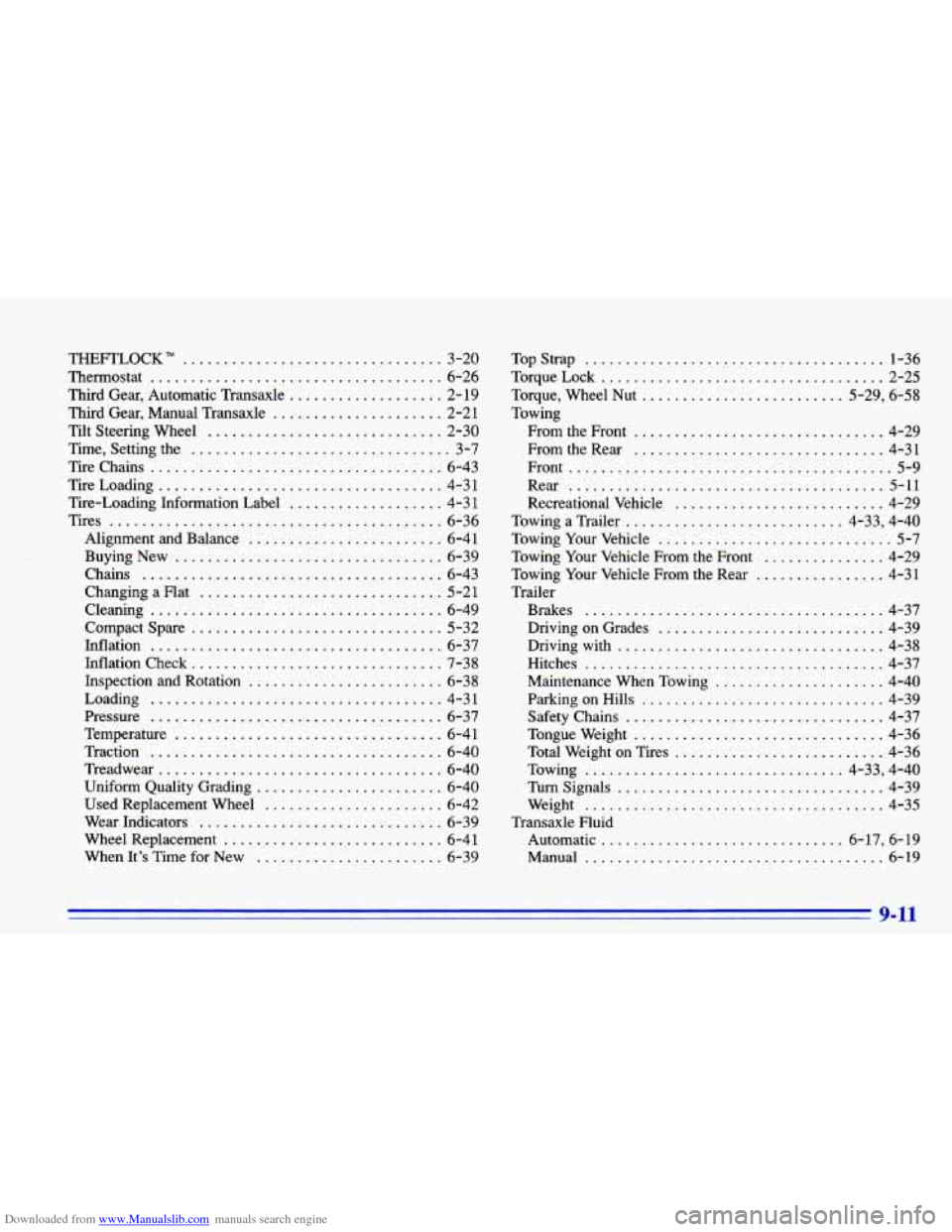
Downloaded from www.Manualslib.com manuals search engine THEFTLOCK” ................................ 3-20
Thermostat
.................................... 6-26
Third Gear. Automatic Transaxle
................... 2- 19
Third Gear. Manual Transaxle
..................... 2-21
Tilt Steering Wheel
............................. 2-30
Time. Setting the
................................ 3-7
Tire Chains
.................................... 6-43
TireLoading
................................... 4-31
Tire-Loading Information Label
................... 4-3 1
Tires
......................................... 6-36
Alignment and Balance
........................ 6-41
BuyingNew
................................. 6-39
Chains
..................................... 6-43
Changing a Flat
.............................. 5-21
Cleaning
.................................... 6-49
Compact Spare
............................... 5-32
Inflation
.................................... 6-37
Inflation Check
............................... 7-38
Inspection and Rotation
........................ 6-38
Pressure
.................................... 6-37
Temperature
................................. 6-4 1
Traction
.................................... 6-40
Treadwe ar
................................... 6-40
Uniform Quality Grading
....................... 6-40
Used Replacement Wheel
...................... 6-42
Wear Indicators
.............................. 6-39
Wheel Replacement
........................... 6-41
When
It’s Time for New ....................... 6-39
Loading
.................................... 4-31 TopStrap
..................................... 1-36
Torque Lock
................................... 2-25
Torque, Wheel Nut
......................... 5-29, 6-58
Towing From the Front
............................... 4-29
From the Rear
............................... 4-31
Front
........................................ 5-9
Rear ....................................... 5-11
Recreational Vehicle
.......................... 4-29
Towing a Trailer
........................... 4-33. 4-40
Towing Your Vehicle
............................. 5-7
Towing Your Vehicle From the Front
............... 4-29
Towing Your Vehicle From the Rear
................ 4-31
Trailer Brakes
..................................... 4-37
Driving on Grades
............................ 4-39
Driving with
................................. 4-38
Hitches
..................................... 4-37
Maintenance When Towing
..................... 4-40
Parking on Hills
.............................. 4-39
Safety Chains
................................ 4-37
Tongueweight
............................... 4-36
Total Weight on Tires
.......................... 4-36
Towing
................................ 4-33, 4-40
Turnsignals
................................. 4-39
Weight
..................................... 4-35
Automatic
.............................. 6-17. 6-19
Manual
..................................... 6-19
Transaxle Fluid
9-11
Page 370 of 372
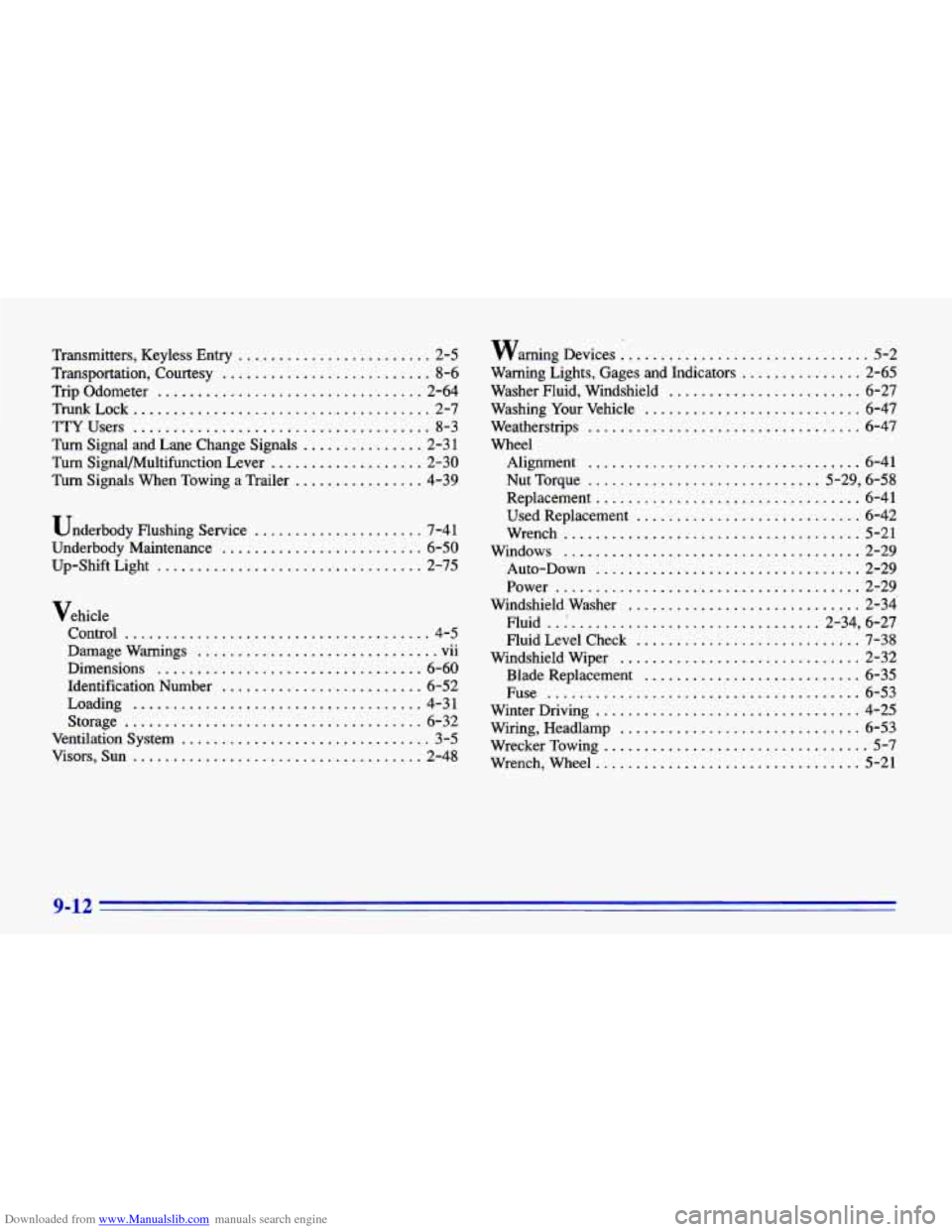
Downloaded from www.Manualslib.com manuals search engine Transmitters. Keyless Entry ........................ 2-5
Transportation. Courtesy .......................... 8-6
Trip Odometer ................................. 2-64
Trunk Lock ..................................... 2-7
TTYUsers ...................................... 8-3
Turn Signal and Lane Change Signals ............... 2-3 1
Turn SignaVMultifunction Lever ................... 2-30
Turn Signals When Towing a Trailer ................ 4-39
Underbody Flushing Service ..................... 7-41
Underbody Maintenance ......................... 6-50
Up-Shift Light ................................. 2-75
Vehicle
Control
...................................... 4-5
Damage Warnings .............................. vii
Dimensions
................................. 6-60
Identification Number ......................... 6-52
Loading .................................... 4-31
Storage ..................................... 6-32
Ventilation System ............................... 3-5
Visors. Sun .................................... 2-48
warning Devices ; .............................. 5-2
Warning Lights. Gages and Indicators ............... 2-65
Washer Fluid. Windshield ........................ 6-27
Washing Your Vehicle ........................... 6-47
Wheel Weatherstrips
.................................. 6-47
Alignment .................................. 6-41
Nut Torque ............................. 5-29. 6-58
Replacement ................................. 6-41
Used Replacement ............................ 6-42
Wrench ..................................... 5-21
Windows ..................................... 2-29
Auto-Down ................................. 2-29
Power ...................................... 2-29
Windshield Washer ............................. 2-34
Fluid ................................... 2-34. 6-27
FluidLevelCheck ............................ 7-38
Windshield Wiper .............................. 2-32
Blade Replacement ........................... 6-35
Fuse ....................................... 6-53
Winter Driving ................................. 4-25
Wiring. Headlamp .............................. 6-53
WreckerTowing ................................. 5-7
Wrench. Wheel ................................. 5-21
9-12